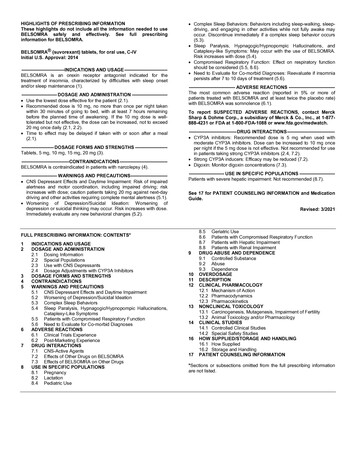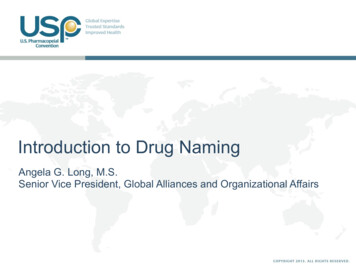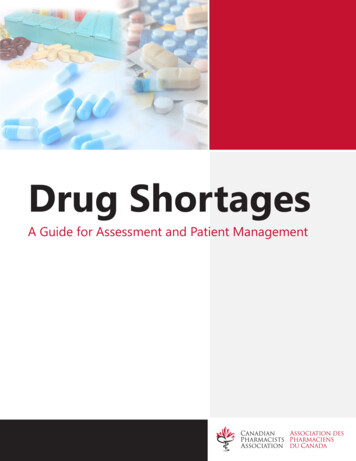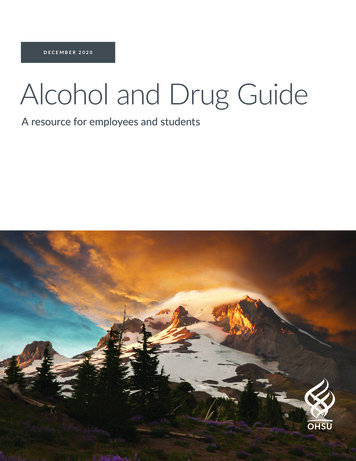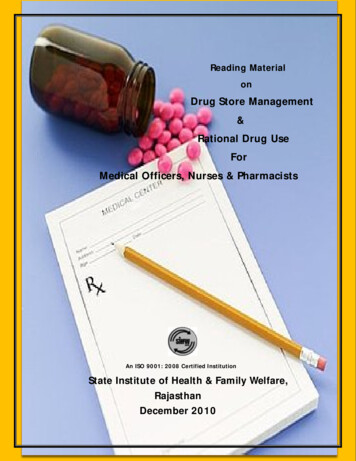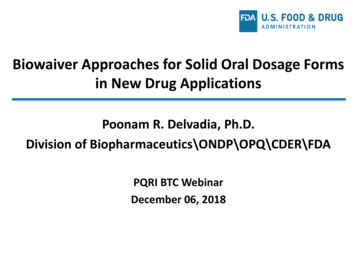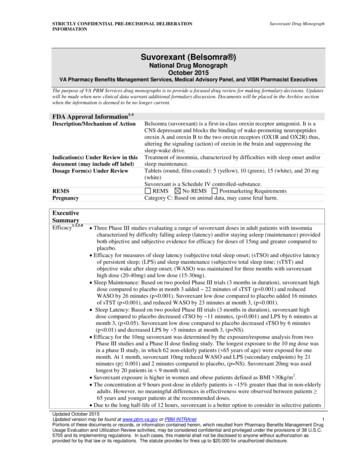
Transcription
STRICTLY CONFIDENTIAL PRE-DECISIONAL DELIBERATIONINFORMATIONSuvorexant Drug MonographSuvorexant (Belsomra )National Drug MonographOctober 2015VA Pharmacy Benefits Management Services, Medical Advisory Panel, and VISN Pharmacist ExecutivesThe purpose of VA PBM Services drug monographs is to provide a focused drug review for making formulary decisions. Updateswill be made when new clinical data warrant additional formulary discussion. Documents will be placed in the Archive sectionwhen the information is deemed to be no longer current.FDA Approval Information1-4Description/Mechanism of ActionIndication(s) Under Review in thisdocument (may include off label)Dosage Form(s) Under ReviewREMSPregnancyBelsomra (suvorexant) is a first-in-class orexin receptor antagonist. It is aCNS depressant and blocks the binding of wake-promoting neuropeptidesorexin A and orexin B to the two orexin receptors (OX1R and OX2R) thus,altering the signaling (action) of orexin in the brain and suppressing thesleep-wake drive.Treatment of insomnia, characterized by difficulties with sleep onset and/orsleep maintenance.Tablets (round, film-coated): 5 (yellow), 10 (green), 15 (white), and 20 mg(white)Suvorexant is a Schedule IV controlled-substance.REMSNo REMSPostmarketing RequirementsCategory C: Based on animal data, may cause fetal harm.ExecutiveSummaryEfficacy1-3,5-8 Three Phase III studies evaluating a range of suvorexant doses in adult patients with insomniacharacterized by difficulty falling asleep (latency) and/or staying asleep (maintenance) providedboth objective and subjective evidence for efficacy for doses of 15mg and greater compared toplacebo. Efficacy for measures of sleep latency (subjective total sleep onset; (sTSO) and objective latencyof persistent sleep; (LPS) and sleep maintenance (subjective total sleep time; (sTST) andobjective wake after sleep onset; (WASO) was maintained for three months with suvorexanthigh dose (20-40mg) and low dose (15-30mg). Sleep Maintenance: Based on two pooled Phase III trials (3 months in duration), suvorexant highdose compared to placebo at month 3 added 22 minutes of sTST (p 0.001) and reducedWASO by 26 minutes (p 0.001). Suvorexant low dose compared to placebo added 16 minutesof sTST (p 0.001), and reduced WASO by 23 minutes at month 3, (p 0.001). Sleep Latency: Based on two pooled Phase III trials (3 months in duration), suvorexant highdose compared to placebo decreased sTSO by 11 minutes, (p 0.001) and LPS by 6 minutes atmonth 3, (p 0.05). Suvorexant low dose compared to placebo decreased sTSO by 6 minutes(p 0.01) and decreased LPS by 5 minutes at month 3, (p NS). Efficacy for the 10mg suvorexant was determined by the exposure/response analysis from twoPhase III studies and a Phase II dose finding study. The longest exposure to the 10 mg dose wasin a phase II study, in which 62 non-elderly patients ( 65 years of age) were exposed for onemonth. At 1 month, suvorexant 10mg reduced WASO and LPS (secondary endpoints) by 21minutes (p 0.001) and 2 minutes compared to placebo, (p NS). Suvorexant 20mg was usedlongest by 20 patients in 9 month trial. Suvorexant exposure is higher in women and obese patients defined as BMI 30kg/m2. The concentration at 9 hours post-dose in elderly patients is 15% greater than that in non-elderlyadults. However, no meaningful differences in effectiveness were observed between patients 65 years and younger patients at the recommended doses. Due to the long half-life of 12 hours, suvorexant is a better option to consider in selective patientsUpdated October 2015Updated version may be found at www.pbm.va.gov or PBM INTRAnet1Portions of these documents or records, or information contained herein, which resulted from Pharmacy Benefits Management DrugUsage Evaluation and Utilization Review activities, may be considered confidential and privileged under the provisions of 38 U.S.C.5705 and its implementing regulations. In such cases, this material shall not be disclosed to anyone without authorization asprovided for by that law or its regulations. The statute provides for fines up to 20,000 for unauthorized disclosure.
STRICTLY CONFIDENTIAL PRE-DECISIONAL DELIBERATIONINFORMATIONSafety1-3,7, 910Suvorexant Drug Monographfor sleep maintenance insomnia versus sleep initiation. The incidence of adverse effects is dose-related. In pooled data from 3-month Phase III trials and the first 3 months of a 12 month Phase III trial,the most common adverse events ( 2% greater than placebo) with high dose suvorexant wassomnolence: 10.7%, (95% CI 11, 18); NNH 13. In pooled data from 3-month Phase III trials and the first 3 months of a 12 month Phase III trial,the most common adverse events ( 2% greater than placebo) with low dose suvorexant wassomnolence 6.7%, (95% CI 17, 82); NNH 28. The incidence of somnolence with suvorexant 10 mg was 1.6% compared to 0.4% with placeboduring a one year trial in patients with primary insomnia. In a trial with 22 healthy men (age 1845 years), the incidence of somnolence the morning after evening administration was 4.5% vs.0% with 10mg suvorexant compared to placebo. No discontinuation of suvorexant 10mg due to an adverse event in a Phase II trial was seen at onemonth (n 62). In other trials, the incidence of discontinuation due to an adverse reaction withsuvorexant 15mg or 20mg was 3% compared to 5% placebo. The risk of next-day impairment, including impaired driving, is increased if suvorexant is takenwith less than a full night of sleep remaining, a higher than recommended dose is taken, coadministered with other CNS depressants, or co-administered with other drugs that increaseblood levels of suvorexant. No meaningful differences in safety were observed between patients 65 years and over andyounger patients at the recommended doses to date. In completed clinical trials, there was no evidence for physical dependence with prolonged use. Itis not associated with clinically meaningful rebound insomnia or withdrawal symptoms afterdiscontinuation. No clinically significant respiratory depression in mild-to-moderate obstructive sleep apnea(OSA) and mild-to-moderate chronic obstructive pulmonary disease (COPD). Increased risk of suicidal ideation appears to be dose-related. Suvorexant was assessed for abuse liability with 40, 80, and 150 mg doses versus placebo, andzolpidem 15 and 30mg in recreational drug abusers. The effects of suvorexant and zolpidemwere similar in the primary endpoint of “drug-liking” on a Visual Analogue Scale but zolpidemshowed greater abuse liability in all other studied categories. No cases of severe cataplexy, although some reports of “weakness” were reported which mightbe considered mild cataplexy. The risk increases with higher doses. CNS Depressant Effects: All CNS depressants can impair daytime wakefulness. Patients shouldbe monitored for somnolence and CNS depressant effects. Impairment can occur in the absenceof symptoms and may not be reliably detected by ordinary clinical exam. The CNS depressanteffects may persist in some patients for up to several days after discontinuation.o Driving and Next-Day Impairment: Suvorexant can impair driving skills and may increase therisk of falling asleep while driving. Impaired driving performance in both male and femalesoccurred when the 20mg dose was taken. Because of individual variation in sensitivity to thedrug, patients taking suvorexant especially those using the 20 mg dose should be cautionedagainst next-day driving and other activities requiring full mental alertness. Drivers poorlypredict their own driving impairment so even at dose of 10mg, there is still a chance of drivingimpairment. Concomitant Medications: Co-administration with other CNS depressants (e.g., benzodiazepines,opioids, alcohol) increases the risk of CNS depression. Patients should be advised not toconsume alcohol in combination with suvorexant due to the additive psychomotor impairment.Dosage adjustments of suvorexant and of concomitant CNS depressants may be necessary whenadministered together. Suvorexant is not recommended for use with strong CYP3A inhibitorsand 5mg is the recommended dose when used with moderate CYP3A inhibitors. The use ofsuvorexant with other drugs to treat insomnia is not recommended. Abnormal Thinking and Behavioral Changes: Discontinuation of suvorexant is advised forpatients that experience any complex sleep behavior (e.g., sleep-driving, preparing and eatingUpdated October 2015Updated version may be found at www.pbm.va.gov or PBM INTRAnet2Portions of these documents or records, or information contained herein, which resulted from Pharmacy Benefits Management DrugUsage Evaluation and Utilization Review activities, may be considered confidential and privileged under the provisions of 38 U.S.C.5705 and its implementing regulations. In such cases, this material shall not be disclosed to anyone without authorization asprovided for by that law or its regulations. The statute provides for fines up to 20,000 for unauthorized disclosure.
STRICTLY CONFIDENTIAL PRE-DECISIONAL DELIBERATIONINFORMATIONPotentialImpactSuvorexant Drug Monographfood, making phone calls). Contraindication: Suvorexant is contraindicated in patients with narcolepsy. Suvorexant promotes a more “physiological sleep” unlike the other available agents used for thetreatment of insomnia. Suvorexant has the indication for treatment of sleep onset and/or sleep maintenance, but due toits long-half life, the primary impact would be for sleep maintenance type of sleep disorders. Patient convenience:o Once daily dosing but it is recommended to be taken within 30 minutes of going to bed, with atleast 7 hours remaining before the planned time of awakening.o Suvorexant does not appear to produce physical dependence or withdrawal.BackgroundPurpose forreviewOthertherapeuticoptionsRecent FDA approvalIssues to be determined: Does the evidence show that suvorexant is effective as an agent for sleep maintenance and sleeponset? Does suvorexant offer advantages over current VA National Formulary (VANF) agents? What are the most appropriate patients for treatment with suvorexant? Are there safety concerns in the Veteran population that may not have been addressed in theclinical trials? What additional safety issues need to be considered with use of suvorexant? Does suvorexant have specific characteristics best managed by the non-formulary process orcriteria for use?Formulary Alternatives (for sleepmaintenance)TemazepamZolpidem IR (not FDA approved for sleepmaintenance)Non-formulary Alternative (if applicable)Zolpidem Extended ReleaseEszopicloneLow dose doxepinOther ConsiderationsBenzodiazepine (intermediate-acting); mean half-life 8 hours, potentialfor tolerance and dependence; associated with other CNS relatedadverse events; morning sedation and cognitive hangover effects, abusepotential, and rebound insomnia on withdrawal. Scheduled C-IV,indicated for short term treatment of insomnia.Mean half-life 1.6 hours; Scheduled C-IV; Recommended dose is 5mgfor women and 5 or 10mg for men, immediately before bedtime with atleast 7-8 hours remaining before the planned time of awakening.Recommended lower dose in geriatric patients and patients with hepaticimpairment with recommended dose is 5 mg for men and women. CNSdepressant effects; abuse and dependence potential; next-dayimpairment; recommended not to drive a car or do things that requireclear thinking the day after taking dose, available generic.Other ConsiderationsMean half-life 2.8 hours; Scheduled C-IV; recommended lower dose inwomen and in patients with hepatic impairment; administeredimmediately before bedtime with at least 7-8 hours remaining beforeplanned time of awakening; CNS depressant effects; abuse anddependence potential; next-day impairment; recommended not to drivea car or do things that require clear thinking the day after taking dose.Half-life 5-7 hours; may extend to 9 hours in older adults. Schedule CIV. Moderate potential for drug-drug interactions (metabolized in partby CYP3A4). Unpleasant metallic taste; available generic.Tricyclic antidepressant. Indication for sleep maintenance only. Nosignificant next-day residual effects.Efficacy (FDA Approved Indications) 1-3,5-8,11Literature Search SummaryA literature search was performed on PubMed/Medline (2010 to August 2015) using the search terms suvorexant,orexin receptor antagonism, and Belsomra. The search was limited to studies performed in humans and published inthe English language. Reference lists of review articles and the manufacturer’s AMCP dossier and transcripts onUpdated October 2015Updated version may be found at www.pbm.va.gov or PBM INTRAnet3Portions of these documents or records, or information contained herein, which resulted from Pharmacy Benefits Management DrugUsage Evaluation and Utilization Review activities, may be considered confidential and privileged under the provisions of 38 U.S.C.5705 and its implementing regulations. In such cases, this material shall not be disclosed to anyone without authorization asprovided for by that law or its regulations. The statute provides for fines up to 20,000 for unauthorized disclosure.
STRICTLY CONFIDENTIAL PRE-DECISIONAL DELIBERATIONINFORMATIONSuvorexant Drug MonographFDA web site were searched for relevant clinical trials. All randomized controlled trials published in peer-reviewedjournals were included.Review of EfficacyCurrent available evidence is high quality for the use of suvorexant in patients with insomnia although the pivotaltrials were conducted and funded by the manufacturer of suvorexant. (Refer to Appendix A).The efficacy of suvorexant in patients with primary insomnia was investigated in three phase III clinical trials. Twoof the trials were randomized, double-blind, placebo-controlled, parallel-group of 3 months in duration includingobjective and subjective assessments with an optional 3-month double-blind extension in Trial 1. Each trial enrolledadult patients (18-64 years) and elderly patients ( 65 years of age) who met DSM-IV-TR criteria for primaryinsomnia and a score 25 on the Mini Mental State Examinations (MMSE).Eligibility for inclusion for both trials was assessed with subjective sleep measures in all patients and approximately75% of the patients also underwent objective evaluation using polysomnography (PSG). Patients with onlysubjective sleep assessment via an electronic sleep diary questionnaire, recruited exclusively from Japan (Trial 1)and Asia Pacific (Trial 2), were randomized if the total sleep time (sTST) was 6.5 hours and the time to sleeponset (sTSO) was 30 minutes for 4 of the 7 nights during screening. Patients screened objectively wererandomized if the sleep latency of persistent sleep (LPS) was 20 minutes and the mean wakefulness afterpersistent sleep onset (WASO) was 60 minutes. Patients in the PSG group were excluded if the apnea-hypopneaindex or a periodic leg movement arousal index was 10 (nonelderly) or 15 in the elderly. Two doses wereevaluated in each age group: high dose (HD), defined as 40 mg or 30 mg for adults, and low dose (LD), defined as20 mg or 15 mg for the elderly. Randomization was to LD, HD, or placebo in a 2:3:3 ratio, respectively and a 1:1:1ratio in those patients that only had subjective assessments. A prespecified multiplicity strategy was used for the twoindications (sleep maintenance and onset) but differed between the two trials. The study was powered for high doseobjective sleep maintenance endpoints.Patient characteristics and baseline symptom severity were similar among treatment groups in both trials. Trial 1randomized 1021 patients (mean age 56 years) of which 42% (n 429) were elderly. For Trial 2, 1019 patients (meanage 57, 41% elderly) were randomized. The percentage of females enrolled in Trial 1 and 2 were 63% and 66%,respectively. Obese patients ( 30 kg/m2) made up 12% and 15% of the total population in Trial 1 and 2;respectively. In all groups, baseline score for all patients was 16 on the Insomnia Severity Index (ISI 0-28 scale).The primary efficacy endpoints for suvorexant 40 mg and 30 mg were a change from baseline at months 1 and 3 forsubjective and objective measures of sleep maintenance (sTST, WASO) and sleep onset (sTSO, LPS), respectively.Secondary end points were the same variables at week 1 for subjective measures and at night 1 for objectivemeasures. These variables were assessed for suvorexant 20 mg and 15 mg as secondary endpoints for Trial 1 andexploratory end points for Trial 2. Other diary end points for both trials were considered exploratory endpoints andincluded the following: number of awakenings (sNAW); wake time after sleep onset (sWASO); sleep quality(sQAL); and refreshed upon awakening (sFRESH).Responder rating scales (exploratory endpoints for both trials) included: Insomnia Severity Index (ISI); ClinicalGlobal Impression-Severity scale (CGI-S); Patient Global Impression-Severity scale (PGI-S) (Trial 2 only); ClinicalGlobal Impression-Improvement scale (CGI-I); Patient Global Impression-Improvement scale (PGI-I).Results: (Refer to Table 1 for details)Sleep Maintenance: Primary Endpoints (sTST, WASO) High dose suvorexant vs. placebo was statistically significant for both primary endpoints at all time points;week1/night1, month 1, and month 3 in both trials, (all p 0.001) Low dose suvorexant vs. placebo was statistically significant for both primary endpoints at all time points in bothtrials. The NNT to achieve 15% improvement in mean sTST with LD suvorexant based on pooled results fromTrials 1 and 2 is 9, 8, and 13 at week 1, month 1, and month 3, respectively. (Refer to Table 2 for details)Updated October 2015Updated version may be found at www.pbm.va.gov or PBM INTRAnet4Portions of these documents or records, or information contained herein, which resulted from Pharmacy Benefits Management DrugUsage Evaluation and Utilization Review activities, may be considered confidential and privileged under the provisions of 38 U.S.C.5705 and its implementing regulations. In such cases, this material shall not be disclosed to anyone without authorization asprovided for by that law or its regulations. The statute provides for fines up to 20,000 for unauthorized disclosure.
Suvorexant Drug MonographSTRICTLY CONFIDENTIAL PRE-DECISIONAL DELIBERATIONINFORMATIONSleep Latency: (sTSO, LPS) High dose suvorexant vs. placebo was statistically significant in improving sleep latency at all time points in bothtrials except LPS at month 3 in Trial 2. Low dose suvorexant vs. placebo was statistically superior for LPS at all time points in Trial 1 except month 3 inTrial 2. For sTSO, LD suvorexant improved at all time points however beyond month 1, the differences observedat month 3 were not tremendously different than month 1. The p values for sTSO were nominally positivecompared to placebo (p 0.04) in both trials at month 3. It should be noted that because the study wasunderpowered for sleep latency outcomes, non-significant findings at some time points for LD is not unexpected.The FDA did rule that because the objective findings for sleep latency (LPS) were positive in Trial 1 and incombination with two nominally subjective sTSO findings in Trial 1 and 2 at month 3, there was sufficientevidence to support the efficacy of low doses for sleep latency. The NNT to achieve 15% improvement in meansTSO with LD suvorexant compared to placebo based on pooled results from Trial 1 and 2 is 8, 12, and 26 at week1, month 1, and month 3, respectively. (Refer to Table 2)Secondary Outcomes:High dose suvorexant vs. placebo sWASO was statistical significant throughout all time points in both trials. sQUAL (patient’s perceptions of sleep) significantly improved in Trial 1 week 1 (p 0.001), month 1(p 0.001), and month 3 (p 0.05). Significant results for sQUAL were also seen for all assessment times inTrial 2. sFRESH was significantly improved with for both week 1, and month 1 in both trials (both p 0 .01) but onlymonth 3 in Trial 2, (p 0 .01). sNAW was not statistically different at any time points in both trials. Clinical and patient global impression scales statistically improved at all time points in both trials.Low dose suvorexant vs. placebo sWASO statistically improved throughout all time points except at month 1, and month 3 in Trial 1 and week 1in Trial 2. sQUAL was statistical significant throughout all time points except at month 3 in Trial 1. sFRESH was statistical significant for all time points except at month 3 in Trial 1 and week 1 in Trial 2. sNAW was not significant at any time points in Trial 1 or Trial 2. Clinical and patient global impression scales improved at all time points in both trials.Table 15: Two Phase 3 Studies: Primary Sleep Maintenance and Sleep Onset EndpointsMean change from baseline (95% CI)/pSleep MaintenanceTrial 1Objective: WASO, minNight 1(Objective)Week 1 (Subjective)-38.4 (-45.5, -32.3)HD vs. Placebo 0.00001-32.5 (-39.3, -25.7)LD vs. Placebo 0.00001Subjective: sTST, min21.4 (15.5, 27.4)HD vs. Placebo 0.00001LD vs. PlaceboTrial 2Month 1Month 3Night 1Month 1Month 3-26.3 (-33.5, -19.2) 0.00001-26.4 (-34.3, -18.4) 0.00001-22.9 (30.3, -15.4)0.00001-16.6 (-24.8, -8.3)0.000009-42.0 (-48.6, -35.3) 0.00001-37.0 (-45.1,-28.8) 0.00001-29.4 (-36.6, -22.3) 0.00001-24.1(-33.0,-15.3)0.00001-29.4 (-36.7, -22.1) 0.00001-31.1 (-40.1, -22.2)0.00000919.6 (12.0, 27.1) 0.0000119.7 (11.9, 27.6) 0.0000126.4 (19.8, 33.1) 0.0000126.3 (18.3,34.3) 0.0000125.1 (16.0, 34.2) 0.0000113.6 (6.9, 20.2)0.0000716.3 (7.9, 24.8)0.0001610.7 (1.9, 19.5)0.01716.8 (9.1, 24.5)0.0000220.9 (11.7, 30.2) 0.0000122.1 (11.5, 32.6)0.00004-10.3 (-15.0, -5.5)0.00002-9.6 (-14.9, -4.3)0.0004-11.2 (-16.3, -6.1)0.00002-10.3 (-16.0, -4.6)0.0004-9.4 (-14.6, -4.3)0.0004-8.1 (-13.8, -2.3)0.0061-21.7 (-28.6, -14.9) 0.00001-12.4 (-20.7, -4.0)0.004-12.1 (-17.8, -6.4)0.00004-7.8 (-15.0, -.7)0.03-3.6 (-10.1, 2.8)0.27-0.3 (-8.3, 7.6)0.93-5.7 (-9.7, -1.6)0.0061-5.6 (-10.2, -1.1)-7.4 (-12.3, -2.5)0.003-5.4 (-10.9, .0)-8.4 (-12.8, -4.0)0.0002-5.2 (-10.2, -.3)-13.1 (-17.7, -8.4) 0.00001-7.5 (-12.9, -2.2)-12.8 (-18.8, -6.9)0.00003-6.9 (-13.7, -.0)-13.2 (-19.4, -7.0)0.00003-7.6 (-14.7, -.4)Sleep OnsetObjective: LPS, minHD vs. PlaceboLD vs. PlaceboSubjective: sTSO, minHD vs. PlaceboLD vs. PlaceboUpdated October 2015Updated version may be found at www.pbm.va.gov or PBM INTRAnet5Portions of these documents or records, or information contained herein, which resulted from Pharmacy Benefits Management DrugUsage Evaluation and Utilization Review activities, may be considered confidential and privileged under the provisions of 38 U.S.C.5705 and its implementing regulations. In such cases, this material shall not be disclosed to anyone without authorization asprovided for by that law or its regulations. The statute provides for fines up to 20,000 for unauthorized disclosure.
Suvorexant Drug MonographSTRICTLY CONFIDENTIAL PRE-DECISIONAL HD Suvorexant 20/40mg; LD Suvorexant 15/30mg; WASO Wake After Sleep Onset; sTST Subjective Total Sleep Time; LPS Latency to onset of persistent sleep;sTSO Subjective Total Sleep OnsetTable 27: NNT for ISI, sTST, sWASO and sTSO with LD Suvorexant: Trial 1 and Trial 2 (pooled results)Suvorexant 15/20mg vs.MeasureTime PointplaceboNNT (95% CI)Month 110 (7-9) 6 point improvement in ISI total scoreMonth 38 (6-14)Week 19 (6-15) 15% improvement in mean sTST (sleep maintenance)Month 18 (6-14)Month 313 (7-46)Week 112(8-39) 15% improvement in mean sWASO (sleep maintenance)Month 112 (8-37)Month 316 (9-102)Week 18 (6-14) 15% improvement in mean sTSO (sleep latency)Month 112 (7-34)Month 326 (NS)ISI, Insomnia Severity Index; sTST subjective total sleep time; sWASO, subjective wake time after sleep onset; sTSO, subjective time to sleep onset;CI, confidence interval; NNT, number needed to treat; NS, not significant.Herring5 et al. conducted a phase II dose-finding two-period cross-over study examining the efficacy of suvorexant10 mg, 20 mg, 40 mg, and 80 mg. A total of 254 adults with primary insomnia were randomized with 60 patientsin each dose arm. Co-primary efficacy end points were objective sleep efficiency (defined as TST/time in bed inminutes [fixed at 480 for this study] multiplied by 100) on night 1 and end of week 4. Secondary endpoints wereWASO and LPS. All suvorexant doses showed significant improvement in sleep efficiency vs. placebo from the firstnight compared with placebo and maintained this treatment difference to the end of the study. All doses compared toplacebo significantly reduced WASO at both time points, (p 0.001). The multiplicity strategy resulted in no dosebeing positive for LPS. However, when an analysis of LPS was performed between the first and second studyperiods to minimize the carryover effect) and applying the multiplicity testing strategy, the 40 mg and 80 mg dosesignificantly improved LPS when compared to placebo at night 1, while the 20 mg resulted in a significantimprovement at week 4. The 10mg dose showed a significant improvement in objective sleep maintenance and forobjective sleep latency when a post-hoc sensitivity analyses was performed. Many of the exploratory patientreported outcomes including sTST, sTSO, sQUAL, sFRESH were negative for both the 10 mg and 20 mg doses atweek 1 and 4 when compared to placebo but again, this study was not powered for those endpoints. Some evidenceof subjective benefit was noted from the scores of insomnia severity index for all doses; however the p-values werenot positive for suvorexant 10 mg. (Refer to Appendix B for more details.)Long-Term Efficacy8:A randomized, placebo-controlled, parallel group Phase III trial in 781 patients with primary insomnia (mean age62) and a BMI 30 kg/m2 in 23% of the total population was conducted to assess the safety and tolerability ofsuvorexant for up to year, while assessing the efficacy for sTST and TSO over the first month of treatment assecondary outcomes. Most patients were mild-to-moderate insomnia at baseline. Adult patients received suvorexant40mg while elderly patients ( 65) received 30mg or placebo at a 2:1 ratio for 1-year with a subsequent 2-monthrandomized discontinuation phase in which patients on suvorexant either continued suvorexant or were abruptlyswitched to placebo. Patients on placebo remained on placebo. (Refer to Safety section for long term findings.)Over the first month, suvorexant showed significant improvement in sTST (p 0.0001) and sTSO (p 0.0002)compared to placebo. The improvements were maintained through the 1-year period. Suvorexant was better thanplacebo on all subjective sleep measures at month 1 and month 12, except for sNAW at month 1. Suvorexant wasalso better than placebo at both time points on the ISI, CGI-S, PGI-S, CGI-I, and PGI-I.Summary of Efficacy:When four double-blind, randomized, placebo-controlled trials evaluating suvorexant for primary insomnia wereincluded in a meta-analysis11, suvorexant was found to be superior to placebo, with regard to two primary efficacyUpdated October 2015Updated version may be found at www.pbm.va.gov or PBM INTRAnet6Portions of these documents or records, or information contained herein, which resulted from Pharmacy Benefits Management DrugUsage Evaluation and Utilization Review activities, may be considered confidential and privileged under the provisions of 38 U.S.C.5705 and its implementing regulations. In such cases, this material shall not be disclosed to anyone without authorization asprovided for by that law or its regulations. The statute provides for fines up to 20,000 for unauthorized disclosure.
STRICTLY CONFIDENTIAL PRE-DECISIONAL DELIBERATIONINFORMATIONSuvorexant Drug Monographsubjective outcomes: sTST (measure of sleep maintenance): WMD -20, (95% CI -25.01, -15.30), (1889 patients, 3trials) and sTSO (measure of sleep latency): WMD -762; (95% CI -11.03, -4.21), (1889 patients, 3 trials). (Refer toTable 1 for specific outcomes with higher vs. lower doses of suvorexant.) The efficacy of suvorexant 10mg wasdetermined by the exposure/response analysis from two Phase III studies and a Phase II dose finding study. Thelongest exposure to the 10 mg dose was in a phase 2 study, in which 62 non-elderly patients ( 65 years of age) wereexposed for one month.Potential Off-Label Use 12-13 No published studies at the time of this document were found using suvorexant in other off-label conditions. Otherdual orexin receptor antagonists have been evaluated in painful diabetic neuropathy, migraine prophylaxis, and asan adjunctive therapy in major depressive disorder.Safety1-3 (for more detailed information refer to the product package insert)Boxed ts None Do not use in patients with narcolepsy. Daytime somnolence: Risk of impaired alertness and motor coordination, includingimpaired driving can occur; the risk increases with dose escalation. Caution patientstaking 20mg against next-day driving and other activities requiring complete mentalalertness. The risk of impairment can occur even when fully awake. Need to evaluate for co-morbid diagnoses: Reevaluate if insomnia persists after 7 to 10days of treatment. Nighttime “sleep-driving” and other complex behaviors while out of bed and not fullyawake can occur. The risk increases with dose escalation, with use of CNSdepressants, and with alcohol. Depression: Worsening of depression or suicidal thinking may occur. The riskincreases with dose escalation. Compromised respiratory function: The effect on respiratory function should beconsidered. Sleep paralysis, hypnagogic/hypnopompic hallucinations, and cataplexy-likesymptoms: The risk increases with dose escalation.Safety ConsiderationsAdverse effects are strongly dose-related. Key safety issues include: Daytime somnolence/excessive daytime sleepin
the most common adverse events ( 2% greater than placebo) with low dose suvorexant was somnolence 6.7%, (95% CI 17, 82); NNH 28. The incidence of somnolence with suvorexant 10 mg was 1.6% compared to 0.4% with placebo during a one year trial in patients with primary insomnia. In a trial with 22 healthy men (age 18-
